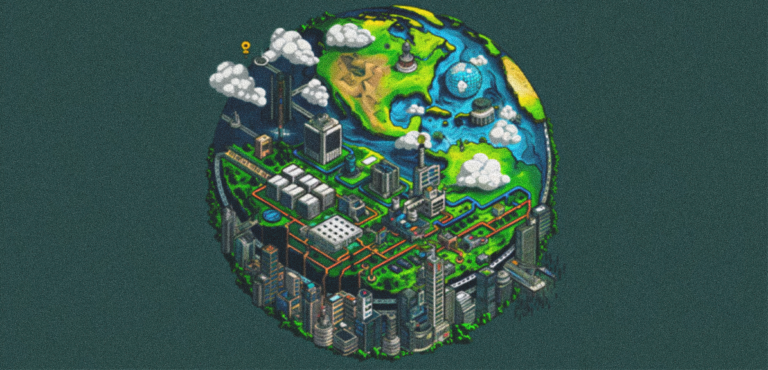Article

How Can Your Org Explore Tech Upcycling?
As our personal and professional lives adapt new technology into our routine, the constant churn of new devices leaves behind a growing mountain of electronic waste (e-waste). E-waste is the fastest-growing waste stream globally, and its toxic cocktail of materials like lead, mercury, and arsenic often leach into soil and water, contaminating ecosystems and posing human health risks.
But what if there was a way to give these outdated gadgets a second life, reducing waste and even sparking creativity? Let’s talk tech upcycling.
Tech upcycling breathes new life into old devices, transforming them into something functional and often surprisingly creative. This not only reduces e-waste but also offers a sustainable alternative to constantly buying new gadgets. Upcycling projects can range from simple to complex, catering to different technical skill sets.
The environmental benefits of tech upcycling
Upcycling tech offers a multitude of environmental benefits through reduced e-waste. Every device upcycled is one less device ending up in a landfill, minimizing the environmental impact of e-waste.
Upcycling reduces the need to extract virgin materials for new electronics, preserving natural resources like metals, rare earth elements, and fossil fuels. The near seemingly constant production of new electronics is energy-intensive, requiring vast amounts of electricity and water. Upcycling existing devices reduces the overall energy consumption associated with the tech industry. This translates to a smaller carbon footprint.
What can be safely upcycled?
Smartphones are a prime candidate for upcycling. Their built-in cameras and internet connectivity make them perfect for DIY security cameras. With a few apps and a creative mount, you can monitor your home remotely, offering peace of mind without breaking the bank.
For those with some technical know-how, older computers can be revitalized by upgrading specific components. Replacing a slow hard drive with a solid-state drive (SSD) can breathe new life into an aging machine, making it suitable for basic tasks, web browsing, and even light gaming.
Upcycling tech can be a powerful tool for education. Donated tablets and laptops can be refurbished and distributed to underprivileged schools, promoting digital literacy and access to information. Old computer parts can be used to build basic robots, introducing students to coding and engineering concepts in a fun and interactive way.
Where businesses can promote tech upcycling
While individual efforts are crucial, businesses also have a significant role to play in promoting tech upcycling. Here are some ways companies can contribute to a more circular economy for electronics:
- Take-back and refurbishment programs: Manufacturers can establish take-back programs where consumers can return old devices. These devices can then be refurbished and resold at a discounted price, offering a sustainable alternative to new products. This not only reduces e-waste but also creates new revenue streams for businesses.
- Designing for upgradability: Tech companies can design products with modular components that are easier to upgrade and repair. This extends the lifespan of devices and reduces the need for frequent replacements. Standardizing components across different product lines can further facilitate upgrades and repairs. For example, a laptop with a removable and easily replaceable battery allows users to extend the life of their device without needing to purchase a whole new one. Additionally, manufacturers can provide readily available spare parts and user-friendly repair manuals in the UK. This empowers consumers to fix their own devices, further extending their lifespan and reducing reliance on professional repair services.
- Upcycled product lines: Forward-thinking companies can develop entirely new product lines made from upcycled materials. This creates an e-waste market and encourages consumers to embrace sustainable practices. For instance, companies could create speakers from recycled computer parts or laptop sleeves from repurposed leather scraps. These upcycled products can be marketed as eco-friendly alternatives, attracting environmentally conscious consumers in the UK and abroad.
Real world examples of sustainable companies
Several companies are setting a positive example by integrating upcycling principles into their business models:
The Restart Project (UK): This non-profit organisation focuses on extending the lifespan of electronics through repair workshops and educational initiatives. They empower individuals to fix their own devices and reduce e-waste by providing the skills and knowledge necessary for DIY repairs. The Restart Project’s mission is to create a more sustainable future for technology by fostering a culture of responsible consumption and repair in the UK.
Dell’s Recommerce Program (USA): While not based in the UK, Dell offers a take-back program for used electronics, refurbishing them for resale and responsibly recycling those beyond repair. This program provides consumers with a convenient way to dispose of old devices while giving them a second life.
Fairphone (Netherlands): These mobile phone manufacturers are committed to ethical sourcing and sustainable design. Their phones are modular and easy to repair, extending their lifespan and minimizing e-waste. Fairphone also offers readily available spare parts and repair guides, empowering users to maintain their devices and reduce their overall environmental impact.
Patchwork (Canada): Patchwork creates unique and functional tech accessories like phone cases and laptop sleeves from upcycled materials like leather scraps and billboards. These products demonstrate the aesthetic potential of upcycled materials and offer consumers stylish and sustainable tech accessories.
Distilled
By encouraging individuals, businesses, and policymakers to promote tech upcycling, we can create a circular economy for electronics where resources are used efficiently and waste is minimized. Upcycling is not just about giving old tech a second chance – it’s about fostering a culture of innovation, responsibility, and a more sustainable future for our planet.